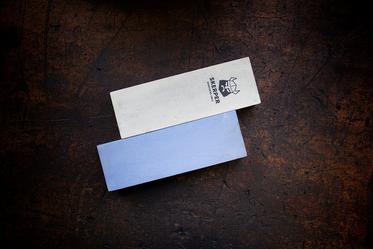Sharpening stone, whetstone, water stone: the meaning behind
Sharpening stone, whetstones and water stones: we often come across these terms. Also on our own website. But what are the differences between these terms? Or: are they even different at all?? We offer you an insight into this semantic discussion.
Why not start with ‘sharpening stones’. It is the collective term for all stones you use to sharpen knives, chisels, scissors, axes, in short everything with an edge. There are natural sharpening stones that are taken directly from nature, and artificial sharpening stones that are produced in a factory. The last group is often categorized based on the sharpening material used, or the country of origin. We sell, for instance, ceramic sharpening stones, diamond sharpening stones and Japanese sharpening stones.
Whetstones
Another term often used for sharpening stones is whetstone. Both terms mean exactly the same. After all to whet is to sharpen! It is a rather dated term but one that is still used regularly.
The materials used for these sharpening/whetstones are very diverse. Factory stones are mostly made from aluminium oxide, ceramics or diamond. The latter means: they have a diamond-coated sharpening layer, mounted to a steel or aluminium sheet. Natural sharpening stones, such as the Ardennes Coticule stones consist of grenades, while stones from the American Arkansas mountains have novaculite as an abrasive.
So what are water stones?
The best sharpening stones (or whetstones) come from Japan. At least that is the generally accepted view, one we gladly endorse. After all, the Japanese are absolute experts when it comes to sharpening. Japanese sharpening stones are made from different materials and should generally be used in combination with water. This creates a ‘slurry’, because the water mixes with the loose sharpening particles. The advantage is that sharpening is easier and faster. In addition, the material that is removed immediately drains away because of the water. As such no metal particles can get caught in the stone which could cause scratches on the knife.
It is therefore not that surprising that Japanese sharpening stones are also often called water stones. Some water stones need to be submerged in water for them to fill up while others are ‘splash & go’. This means that only the surface of the stone needs to be wet and should remain wet during the sharpening process. For practically all Japanese sharpening stones applies that either one of these two methods of using water is necessary or strongly recommended.
The exception being Japanese diamond sharpening stones, such as the Naniwa Diamond Stones collection. After all diamonds don’t wear out, which means that no particles are released while sharpening. There is therefore also no such thing as slurry when you sharpen your knives on diamond sharpening stones. You could, however, add a little water to the stone to make sharpening a little easier and less noisier.
Are water stones exclusively Japanese?
Although they are often used together, ‘Japan’ and ‘water stone’ don’t necessarily have to go together. Not every Japanese sharpening stone is a water stone and not every water stone comes from Japan. Does this mean that non-water stones should be used ‘dry’. No, this is also not the case. Instead of water you could also add a couple drops of oil to the surface of some whetstones. This mostly applies to very hard natural sharpening stones. In general, however, the following applies: most common (non-diamond-coated) whetstones could be typified as water stones.
The advantage of the (rare) oil stone is that they don’t wear out as quickly as the softer water stones. Water stones, however, remove a lot more material and are therefore a lot faster to work with. The difference between the two is caused by the binding agent that is used. The sharpening particles of a water stone are bound by softer material, the particles of an oil stone by harder material. Magnesium, for instance, which responds strongly to water but is still very strong. For that reason you should never submerge magnesium-bound sharpening stones.
So the conclusion is…?
To conclude: sharpening stones and whetstones are the same and water stones are a frequently occurring sub-category of these stones. So don’t be confused by the logical suggestion that a whetstones should always be used in combination with water. That is not the case. In addition, water stones don’t always come from Japan.
When choosing a sharpening stone (or stones) you should always keep your goal in mind. Do you want to polish your knives? If you do you shouldn’t choose the diamond sharpening stone or an oil stone. In that case we recommend you always use a water stone with a high grain size. However, if you are also satisfied with less sharpness and want fast results diamond stones are a great option. Finally, do you only want to purchase one sharpening stone but use multiple ‘grits’? Why not opt for the Ardennes Coticule sharpening stone where the amount of slurry you create determines how fine you can sharpen.








